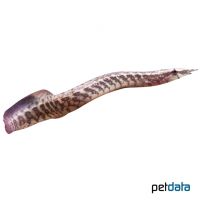East African Spiny Eel (Mastacembelus frenatus)
| East African Spiny Eel Mastacembelus frenatus | |
|---|---|
| Name | East African Spiny Eel |
| Name Lat. | Mastacembelus frenatus |
| Family | Spiny Eels |
| Family lat. | Mastacembelidae |
| Order | Spiny Eels |
| Order lat. | Synbranchiformes |
| Origin | Africa |
| Habitat | Rivers, lakes |
| Diet | Carnivore |
| pH | 7.5-8.5 |
| Behavior | Nocturnal, peaceful |
| Keeping | Individual, group |
| Care Level | Moderate |
| Reproduction | Egg scatterer |
| Breeding | None reported |
| Life Span | 8-10 years |
| Protection | No |
| Metric Units | |
| Size | 25-40 cm |
| Temperature | 23-27 °C |
| Hardness | 7-30 °dH |
| Aquarium | ~ 400 l |
| US Units | |
| Size | 10"-16" |
| Temperature | 73-81 °F |
| Hardness | 125-534 ppm |
| Aquarium | ~ 100 gal |
Distribution and habitat
The crepuscular to nocturnal bridled spiny eels are native to Lake Victoria and Lake Tanganyika and their catchment areas, the upper Zambezi and Okavango, and the upper Congo. They live in rivers, lakes and swamps, hidden under aquatic plants during the day.
Maintenance
The aquarium should have a dense border planting, with roots, stones and caves (clay tubes), which offer hiding places as well as free sand areas. To be able to burrow in, they need a soft, fine-grained substrate (sand, round gravel). A weak current and some subdued light (e.g. floating plants) is ideal
No ammonia, ammonium and nitrite should be detectable, the nitrate value should not exceed 100 mg/l. To ensure the water quality and oxygen content, a filter and heater adapted to the aquarium size is required, as well as lighting for the species-appropriate day-night rhythm of the animals.
Diet
The food supply consists of live and frozen food. For a balanced diet, according to their size, feed once a day with Tubifex, mosquito larvae, krill, shrimp, earthworms, crab and fish meat, etc. (live or frozen). Freeze-dried food or dry food is rarely accepted.
Only feed as much as is eaten overnight. Regular and varied feeding promotes health and increases resistance.
Behaviour and compatibility
It is recommended to keep these peaceful fish either individually or in a group of at least 5 animals. To avoid ranking fights, they should be placed in the aquarium at the same time. Keeping a group is only possible in a larger, richly structured (shelters) tank. They can be well socialized with other not too small or aggressive fish. Fish that are too small are considered food
Basically, only compatible fish species with similar demands on water condition and water temperature may be socialized.
Sex dimorphism
The sexes are difficult to distinguish. The slightly larger females appear much plumper at spawning time.
Reproduction and breeding
There are no known reports of successful breeding in the aquarium.
Important
They have sensitive skin due to the lack of scales and are therefore susceptible to skin diseases. Sharp-edged or rough furnishings (e.g. lava stones, unglazed clay pipes) should be avoided, as these can cause skin injuries and thus infections. For skin care, a substrate of sand or fine, round-grained gravel is recommended, as well as frequent partial water changes.
A tightly closing aquarium cover is absolutely necessary, since they can escape through the smallest openings.
The well-being of the fish should be checked regularly. Temperature should be checked daily, pH, hardness and nitrate levels at least every 14 days. Regular partial water changes are recommended, even if the contaminant level has not yet reached the upper limit. Sudden changes in water quality should be avoided. Newly introduced fish must be accustomed slowly to the water in the aquarium
Further literature can be found in your pet store.
References
Text: Werner Winter; Image: petdata
Source: BMELV (1998): Tierschutzgutachten - Haltung von Zierfischen (Süßwasser); ENGELMANN (2005): Zootierhaltung - Tiere in menschlicher Obhut: Fische, Zootierhaltung, Verlag Harri Deutsch; BAENSCH & RIEHL (2006): Aquarien Atlas Bd. 4, Mergus Verlag
- Gemäß § 21 Abs. 5 Tierschutzgesetz idgF
